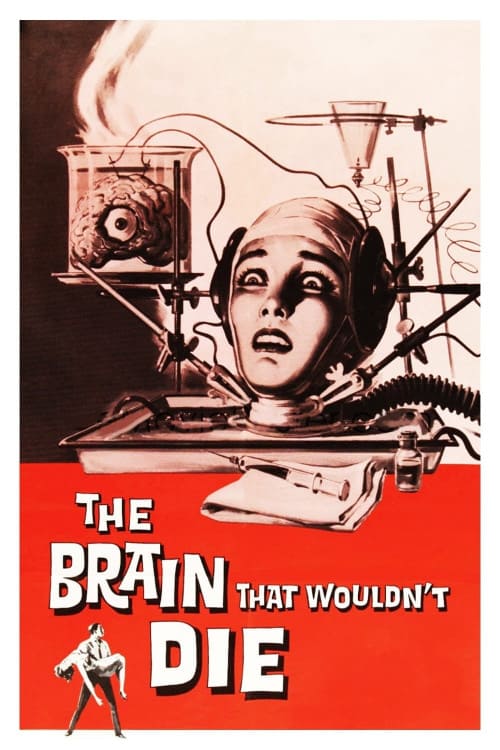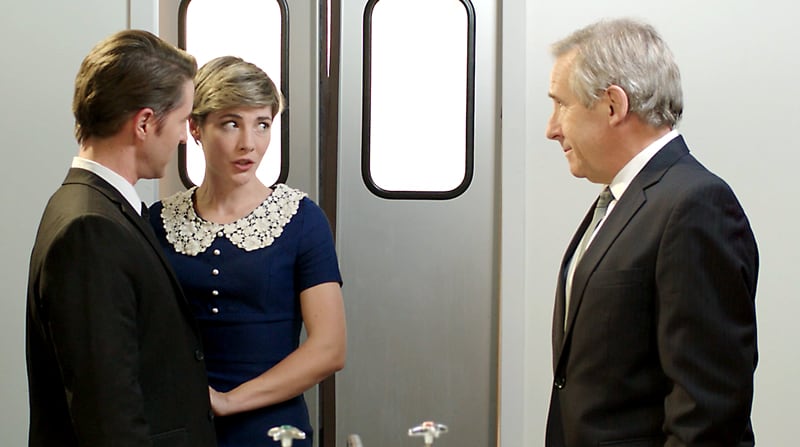
★★★1/2 out of ★★★★★
“Let me DIE! Let me Die!” The Brain that Wouldn’t Die is a loving note-for-note recreation of one of the great B movies of the 1960s. Cheeky and continually winking at the audience, the film embraces the silly camp classic and giving it a fresh coat of 4K technicolor paint.
Directed by Derek Carl

The Portland Horror Film Festival selected a locally produced film for its world premiere showcase for 2020, The Brain That Wouldn’t Die , a near shot-for-shot remake of a movie by the same name from 1962. From the opening cries of “Let me die! Let me die!” and the big block letters of the opening crawl, this version took great lengths to pay homage and respect its source material. The difference, and it is nimbly subtle, is that the 2020 version has a wry self-aware sense of humor tucked into the story.
The story is classic mad science. A brilliant young and ambitious surgeon, Dr. Bill Courtner (Patrick D. Green) is obsessed with risky experiments with extending brain activity after death and the transplant of severed limbs, showing off his skills by taking over a failed surgery that left one of his father’s (David Withers) patients dead on the surgery table and bringing it back to life. While rushing to his father’s villa, where one of his unsavory lab experiments has gone amuck, he crashes his convertible, killing his nurse and fiance, Jan Compton (Rachael Perrell Fosket).
In his desperation, Dr. Courtner grabs Jan’s severed head and rushes back to his lab in the villa, and rigs up a contraption of tubes, paddles, and a pan of secret sauce to keep Jan’s head alive. After successfully rousing Jan, he rushes out to find a replacement body, leaving Jan’s head with his lab lackey Kurt (Jason Reynolds)… and something monstrous locked in a secret room. Of course, when out looking for the replacement body, where does he go? To burlesque parlors, prostitutes, and beauty pageants, of course! After scouring a number of nightspots, he finally settles on pin-up model Doris Powell (Mia Allen) as the ideal body to attach his beloved Jan’s head to.
While Courtner is away, Jan plots her revenge, finding a telepathic bond with the thing in the other room. Also detective Mancini (Robert Blanche) has picked up the mysterious trail leading from the accident with all signs pointing to Courtner. For all his supposed brilliance, the mad doctor’s recklessness and hubris are catching up with him to a grand and goofy denouement.

Robert Blanche and Patrick Green in The Brain That Wouldn’t Die 
Patrick Green in The Brain That Wouldn’t Die!
The Brain That Wouldn’t Die was then, and is now, a zero-budget stage play with some fun props, a bit of cheesecake, and lots of melodrama. Rather than make a modern update, the Derek Carl recreates the 1962 look of the film. The sets, the cars, the decorations, and fashions all are rat-pack era vintage. What’s more, the sets look remarkably like the original, and the closing credits like to show off the similarities of the cast and the sets. I applaud this decision to keep the film a period piece.
Even the vocal affectations are recreations of a bygone era. So earnest! Green really hams it up, with dramatic glowering stares, and manic ear-to-ear grins. In Fosket, the producers found a near spitting image for the first woman to play “Jan in the Pan”, Virginia Leith. Unlike Leith, for whom The Brain that Wouldn’t Die was her last feature, I think Fosket may be able to parlay this fun effort into something bigger and better.
Certainly, this is a film that is limited by its inherently silly source material, which is, after all, a Mystery Science 3000 favorite. It’s not exactly like trying to remake Rosemary’s Baby or Psycho. The stakes just aren’t that high. The dialogue is near soap opera level, and don’t get me started on plausibility. (Doesn’t she need lungs to talk?) But with a comedy horror film like this, you just roll with it. I would argue that this film has a better pace than the original, and the added characters and scenes, such as the inclusion of Detective Mancini and a genuinely funny back story for Kurt helps to absorb some of the slow exposition from the 1962 film, and generate some need for narrative momentum.
The markedly big difference between the original and the remake is how much the color and the crispness of the filming for this one pops. Carl and his team made a film that is much more vibrant and punch than the original, which is frankly a bit of a grey and uninspired effort.

Behind the Scenes at The Brain That Wouldn’t Die 
Patrick Green, Rachael Perrell Fosket and David Withers in The Brain That Wouldn’t Die.
As a native Portlander, I am proud that a little film like this was staged in my hometown. I was able to pick up that the burlesque club was the old famed strip joint, Mary’s Club (been there… guilty as charged) and that a bevy of Portland acting talent was used. Many of the actors in this film were in Grimm, Leverage, Portlandia, and The Librarians … all Portland TV shows. This was tough guy Robert Blanche’s last film, as he passed away in January of this year. He was a stalwart in the Portland TV scene, appearing in many episodes of Grimm and Leverage. I had a chance to meet and talk with Blanche at the Rose City Comicon, where he was promoting his production of Jason Rising, a Friday the 13th fan film due to be released later this year. He was a great guy, and the Portland acting scene will miss him.
The Brain that Wouldn’t Die is not rated, but I would think it’s PG-13. Interestingly, the original was even a bit racier, which has a brief bit of nudity in it… shocking for the time! This was the world premiere at the PHFF, so I’m expecting that this movie will be on the festival circuit for a while, but I do hope that Shudder picks it up when it comes time for a streaming platform. This is a film that capitalizes on what we loved about the B-movie original and then infusing it with clever wit and visual flair to make it a more enjoyable experience.

